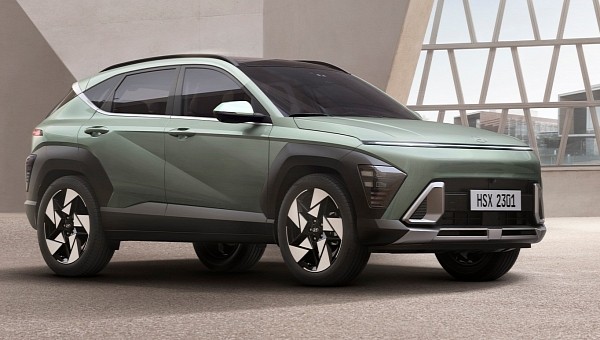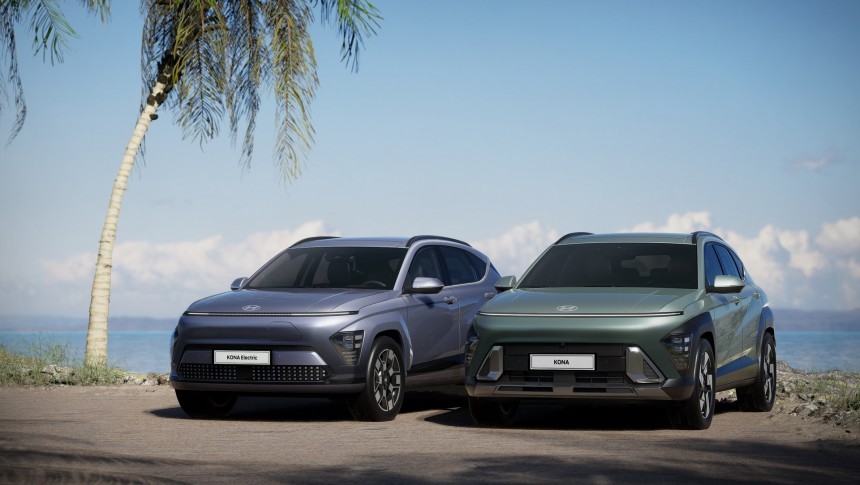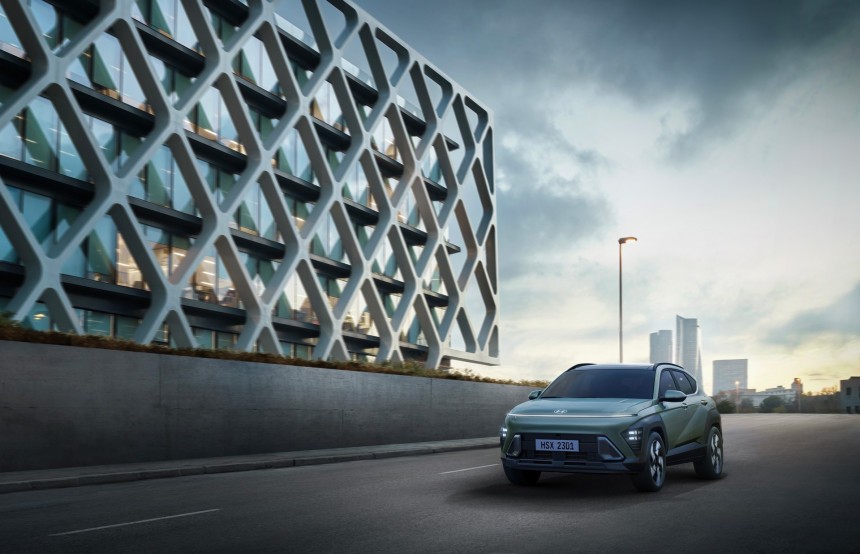Hyundai drops the "N" on their new-generation EV of the KONA, the second version of the Koreans' subcompact SUV, which is due to arrive this year. Alongside the all-electric model, traditional ICE and hybrid powertrains up the Go factor of the small utilitarian.
For now, the company revealed several details about their domestic market variant. We'll have to wait two more months to learn what the new Kona has in stall for the rest of the world. The manufacturer brags about how it centered "the development of the upscaled, futuristic all-new KONA" around its EV model.
Curiously and counterintuitively, Hyundai didn't mention the electric version's traits and specs. Not even the size, let alone critical aspects like powertrain, battery capacity, and whatnots with impact on acquisition decisions. March is the big reveal month for the lightning-eating KONA, so stick around.
So far, we know some fossil-fuel parameters destined for the Korean market. One hundred seventy-one inches (4,350 mm) long, seventy-one inches (1,825 mm) wide, and sixty-two inches (1,580 mm) tall (when wearing the 17-inch rubber boots) over a hundred and five-inch (2,660 mm) wheelbase.
According to official claims, the geometrical values are better put to use for passenger comfort, with more interior room available compared to the present model. 2.5 inches (60 mm) more in the wheelbase sector transform into a three-inch gain (77 mm) for leg-stretching space.
Also, for tall rear-seat occupants (drivers or not), the new KONA will offer 0.5 inches (11 mm) of overhead. Whether this is due to the slim 3.5-inch thick (85 mm) rigid seats or not is another debate, but it should offer more comfort for back passengers. Also, the four-and-a-half-foot wide shoulder room for the second row of seats is said to be the most generous in its class.
The space-saving philosophy is also present in the front half of the cabin, with the gear selector mounted on the steering column (shift-by-wire technology permits this architecture). That means a clean center console that offers more surface for non-essential but welcomed features.
Hyundai suggests that big bags (what exactly is their "big" is not disclosed yet) or cupholders can now occupy the space freed from the gearbox command lever. Again, keep in mind that this is the Korean market-oriented KONA.
The vital aspect of any car – its powertrain – comes in three inline-four piston-punching shapes: a 1.6-liter T-GDi or 2.0-liter Atkinson engine for the pure ICE and a 1.6-liter GDi for the hybrid. None of the powerplants are new – all three engines are found in the present Kona.
The most powerful option is the 1.6 T-GDi, which comes with 195 hp (198 PS) and 195 lb-ft (265 Nm) from its continuously-variable valve-opening duration. The awkwardly-spinning, more efficient Atkinson two-liter yields 147 hp (149 PS) and a measly 132 lb-ft (179 Nm) of torque. An Intelligent Variable Transmission is thrown in to aid the engine in optimizing drivetrain efficiency.
Hyundai explicitly said that all versions of the new KONA – gasoline, hybrid, and electric – will also have an N-badged derivative. Nonetheless, the spicy stuff for their sporty version is kept in the drawer for now. The Koreans say the new Kona N comes with 19-inch N-exclusive alloy wheels, a black roof, metal pedals, and an N-branded shifter.
Sadly, the official gallery does not include the KONA N. However, it does put the electric and combustion versions side by side for a quick comparison. Front and rear Seamless Horizon Lamps are standard – the EV is adorned with Pixelated Seamless Horizon Lamps (the first Hyundai model to apply this design).
The front and rear lamps are integrated into the prominent wheel arches (large enough to house the KONA-first 19-inch wheels) with contrasting black cladding. Due to their air-breathing nature, the ICE and hybrid versions' fronts sport rag-reducing active air flaps (upper and lower on the HEV, upper for the gasoline).
On the inside, a range of tech puts the 2023 KONA in the trend of the computer-based automobile. Software upgrades are an Over-the-Air click away, and car access and engine start are available via Digital Key 2 Touch – an NFC-based tech for smartphones and smartwatches.
Hyundai was very generous in enlisting many safety features in the new KONA: Forward Collision-Avoidance Assist (FCA), Lane Keeping Assist (LKA), Blind-Spot Collision-Avoidance Assist (BCA), Safe Exit Warning (SEW), Intelligent Speed Limit Assist (ISLA), Driver Attention Warning (DAW), Blind-Spot View Monitor (BVM), and High Beam Assist (HBA).
A safe driving experience is Hyundai's core automobile philosophy. Features such as Smart Cruise Control (SCC), Navigation-based Smart Cruise Control (NSCC), Lane Following Assist (LFA), or Highway Driving Assist (HDA) are offered in the future KONA. Also, parking aids come in bunches – you can read about them in the attached press release.
Curiously and counterintuitively, Hyundai didn't mention the electric version's traits and specs. Not even the size, let alone critical aspects like powertrain, battery capacity, and whatnots with impact on acquisition decisions. March is the big reveal month for the lightning-eating KONA, so stick around.
So far, we know some fossil-fuel parameters destined for the Korean market. One hundred seventy-one inches (4,350 mm) long, seventy-one inches (1,825 mm) wide, and sixty-two inches (1,580 mm) tall (when wearing the 17-inch rubber boots) over a hundred and five-inch (2,660 mm) wheelbase.
According to official claims, the geometrical values are better put to use for passenger comfort, with more interior room available compared to the present model. 2.5 inches (60 mm) more in the wheelbase sector transform into a three-inch gain (77 mm) for leg-stretching space.
The space-saving philosophy is also present in the front half of the cabin, with the gear selector mounted on the steering column (shift-by-wire technology permits this architecture). That means a clean center console that offers more surface for non-essential but welcomed features.
Hyundai suggests that big bags (what exactly is their "big" is not disclosed yet) or cupholders can now occupy the space freed from the gearbox command lever. Again, keep in mind that this is the Korean market-oriented KONA.
The vital aspect of any car – its powertrain – comes in three inline-four piston-punching shapes: a 1.6-liter T-GDi or 2.0-liter Atkinson engine for the pure ICE and a 1.6-liter GDi for the hybrid. None of the powerplants are new – all three engines are found in the present Kona.
Hyundai explicitly said that all versions of the new KONA – gasoline, hybrid, and electric – will also have an N-badged derivative. Nonetheless, the spicy stuff for their sporty version is kept in the drawer for now. The Koreans say the new Kona N comes with 19-inch N-exclusive alloy wheels, a black roof, metal pedals, and an N-branded shifter.
Sadly, the official gallery does not include the KONA N. However, it does put the electric and combustion versions side by side for a quick comparison. Front and rear Seamless Horizon Lamps are standard – the EV is adorned with Pixelated Seamless Horizon Lamps (the first Hyundai model to apply this design).
The front and rear lamps are integrated into the prominent wheel arches (large enough to house the KONA-first 19-inch wheels) with contrasting black cladding. Due to their air-breathing nature, the ICE and hybrid versions' fronts sport rag-reducing active air flaps (upper and lower on the HEV, upper for the gasoline).
Hyundai was very generous in enlisting many safety features in the new KONA: Forward Collision-Avoidance Assist (FCA), Lane Keeping Assist (LKA), Blind-Spot Collision-Avoidance Assist (BCA), Safe Exit Warning (SEW), Intelligent Speed Limit Assist (ISLA), Driver Attention Warning (DAW), Blind-Spot View Monitor (BVM), and High Beam Assist (HBA).
A safe driving experience is Hyundai's core automobile philosophy. Features such as Smart Cruise Control (SCC), Navigation-based Smart Cruise Control (NSCC), Lane Following Assist (LFA), or Highway Driving Assist (HDA) are offered in the future KONA. Also, parking aids come in bunches – you can read about them in the attached press release.












